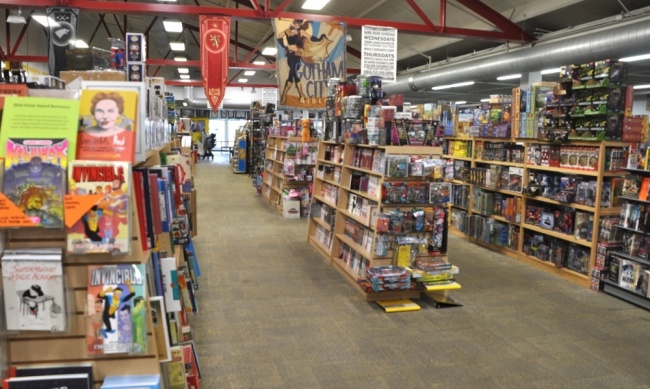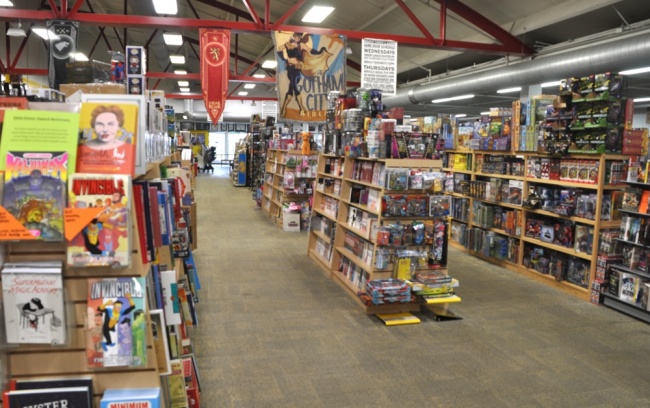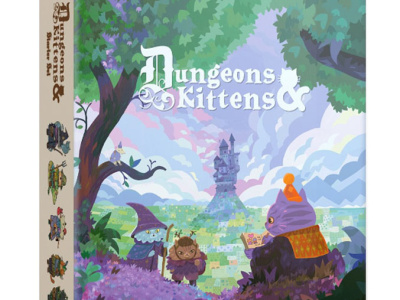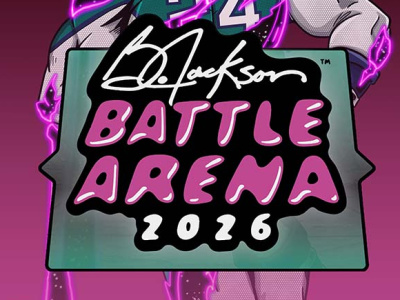Bob Brynildson knows growth.
The former Marine took his discipline from the Corps and added it to retail experience gained as a night manager at a convenience store to become an entrepreneur. He founded Legacy Games in Saint Paul, MN in 1988, and soon merged with and took over a larger store, Source Comics & Games, in 1992. Source became a juggernaut in the Twin Cities of Saint Paul and Minneapolis, and Byrnildson later added another Saint Paul institution, Uncle Sven’s Comic Shoppe, to his portfolio.
Source is indeed a juggernaut at more than 10,000 square feet. Uncle Sven’s? It comes in at 290 square feet and is lovingly called “The comic book mall that’s shaped like a hall.”Brynildson enjoys them both. He mainly works out of Source, but dutifully puts in one day a week working the register at Sven’s, which is where he shared some of his 28 years worth of retail experience with us, both good and bad.
THE GOOD
Buy The Whole Line
When Brynildson got into the comics business, he couldn’t get a massive back-issue inventory right off the bat. So he went deep on the here-and-now, and continues to this day.
“We never cherry-pick a product line,” he said. “We never just carried DC, Marvel, and Image titles. We always tried to carry the vast line, as many different comics as you’d want. That was the thing that really put us on the map. We became that word-of mouth place where you could find the odd treasure you wouldn’t get at other shops.”
Brynildson knows some shops look at unsold obscure titles like boat anchors. But he doesn’t. “If it’s a secondary or tertiary publisher, we just consider them loss leaders,” he said. “We don’t concern ourselves with a profit and loss there. I’d rather be the place you can get everything, and live with a few unsold copies.”
Know Your Ad Target…And When To ChangeBrynildson believes in the power of media.
“I got talked into some TV advertising a few years back, and for 10 years, we put serious money into it. I really think it expanded our market,” he said. And Byrnildson identified his target.
“In the U.S., the TV ad market is female. Women control 75% of the discretionary spending in households, so we advertised to mothers, daughters, sisters, girlfriends, and wives. We advertised on shows we thought a mom would be watching with her son or husband. So when a birthday came around, they knew who we were, and where to go for a gift.”
But Brynildson eventually got out of TV. “Twitter, Facebook, our website and all things internet have surpassed TV’s reach,” he said. “I hired a young woman who is very with it and very trendy, and I told her that 40 to 50 percent of her time on the clock should be managing our social media and internet presence. It’s that important to us now.”
Keep To Your Margins
Pokemon is a cyclical product, and we might be on the third boom-bust cycle by now. But Wizards of the Coast’s Pokemon cards are an object lesson on how Brynildson and Source handle demand-inflated margins.
“We bought pallets of Pokemon cards. It was selling for $9.99 a deck, but guys were selling for $20, $25 a deck at the peak of demand. But we held the line,” Brynildson said. “When parents found out you could get a Pokémon deck from me for $9.99, my Pokémon unit sales went up by 25%. And when it started dying for everyone else, it was still growing by 5% here.”
Byrnildson uses the Pokémon experience as an object lesson. “I have a philosophy that we do not raise the price of a retail product unless the distributor or manufacturer does,” he said. “We stand steady. It pays off in the long run.”
THE BAD
Don’t Run A Clubhouse
“When I first opened up, I was 32, and I thought like a 32-year-old,” Brynildson said. “So I wanted a big, giant clubhouse. I wanted to let people smoke in the back, and when we closed, we’d break out the liquor and we’d have some drinks, play games, and read books.”
The clubhouse lasted…all of three days. “I regretted it immediately. In 2-3 days, I had lost half a dozen customers because of the smoking. The drinks were after hours, but the whole image, the lack of professionalism, was wrong. It took only a few days, but I learned how to be an owner, and really take ownership. At least it wasn’t a two-year experiment. But for a few days, we were every bad cliche about a comic and game store.”
Free Means Free
Free Comic Book Day is now another juggernaut, but it took Source a little while to get the hang of it.
“On our first Free Comic Book Day, we had this idea that we wanted to stretch the books out so that everyone could get one. So we had a limit of one free book,” Brynildson said. “But after just an hour, I realized that we had parents with multiple kids, and there’s nothing more humiliating to an American consumer that to be told ‘no’ when there’s free stuff involved.”
Brynildson would up chasing down customers to give them extra freebies. “I apologized and told everyone ‘I’m sorry. We misread this. This was our first event like this,’” he said. “Giving away free stuff, oddly, might be the sharpest two-edged sword there ever was. You have to open your arms wide, and let everyone in. It’s better to give it all away, and it’s only good when every kid walks out of there with a free comic.”
Don’t Turn A Success Into Failure
“We had a midnight madness sale with deep discounts once that was…a victim of its own success,” Byrnildson said. “We had waits of two to four hours to get people into the store, and even with multiple registers running, people were waiting for up to an hour to check out. We didn’t manage it well.”
Again, Brynildson had to personally apologize to customers. And the “personal” was important.
“It was me, not the employees, telling people face-to-face that I was sorry,” he said. “Fortunately, people can be very forgiving when they see that you are sincere. It all worked out in the end. But I had to make sure it did by eating some crow.”
AND WHAT ELSE?“Our outreach has to be all things. We have a weekly emailer that goes out to thousands of people with the week’s releases and recommended picks. Twice a year, we do a snail mailer as well. We have constant Facebook presence. We just re-did the website with an emphasis on, ‘When you come to The Source, here are the things you can do.’ We don’t worry about what you can buy on the website. We emphasize community on the website. All those things we do are blinking signs that say, ‘Come to the store.’ The emphasis is always on getting you to come here.”
“All advertising is a 3-to-5-year plan. You can’t just hot-spot over the holidays and expect people to remember you in May. It’s a constant.”
“I’m lucky we have good employees. I have some employees who have been here since 1993. They’re the backup for everything we do. I’d be sunk without them.”
“My Google and Yelp reviews are either a 5 or a 1, nothing in the middle. Now fortunately, we get five 5s for every one. But every time you see one of those poor reviews, it hits home. They may be madly insane people, but it still hits you right in the heart.”
“There are three stages to owning a store: There’s the beginning, where you work all the hours. At the end, you get to sit back a bit and watch other people work all the hours. But the middle one—that middle one!—that middle part of your store history is where you grow. A lot of stores fight this. They want control and they want to work all the hours, but you have to let go. It’s people. People, people, people. Hire the right people, treat them right, learn how to manage them, and that’s where you get your growth. It’s all about people. And that makes that end stage of sitting back so much sweeter. You can admire what you’ve all done together, and how you’ve built your community.”












